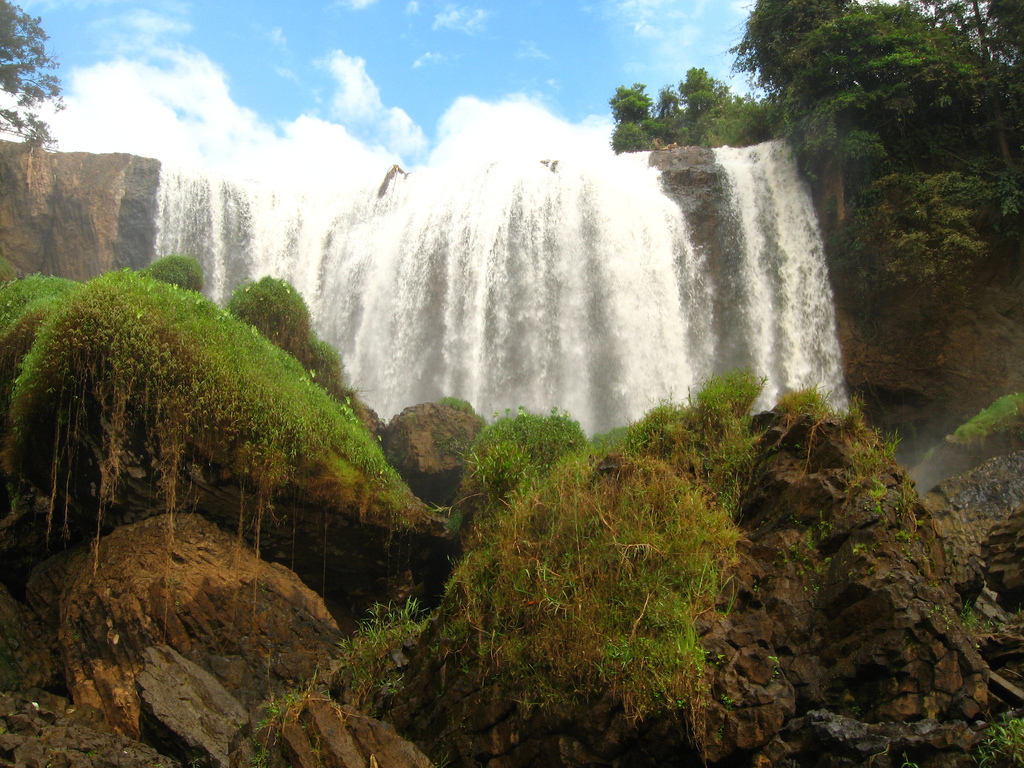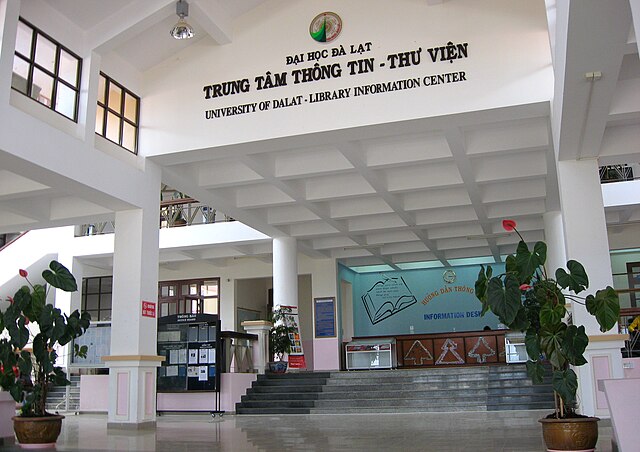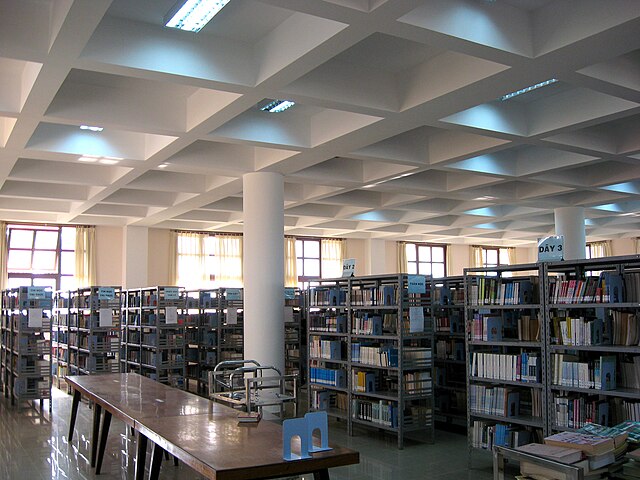The University of Dalat, Vietnam.
The University of Dalat is located on the Lam Vien plateau in southeastern Vietnam. The scenic region boasts a relatively temperate climate, pine forests, flowers, misty lakes, and waterfalls. Originally founded in 1958, in 1976 the University Institute of Dalat was restructured as Dalat University after the unification of Vietnam. It became a major training center for students from South-Central Vietnam and the Central Highlands. The university library strives to fulfill the institution’s educational goals as a center for research and technology, sociology, and international integration. As Professor Dr. Nguyen Duc Hoa, Dalat University President, explains on the university’s website, their core missions consist of
- upgrading the quality of educating and training; updating modern methodology of pedagogy backed by utilization of the M-Book and the Internet; supporting and investing in primary faculties and majors for further advancement;
- standardizing staff; supporting and investing in staff who have potential for research and technology transfer; welcoming scientists and researchers who have earned doctorate degrees in the development of science and technology at Dalat University; investing in new labs for applied research and new production; increasing the quantity and upgrading the quality of scientific research for technology transfer, service, and economic achievements;
- working to develop connections and strengthen cooperations in order to upgrade our educational services and prepare our students for a better future;
- establishing and expanding the roles of student overseers for a better learning and training environment; and
- implementing methods of administrative management with innovative applications of information technology.
Thailand and Vietnam
His Excellency Nguyen Tat Thanh is ambassador of the Socialist Republic of Vietnam to Thailand. In August he told The Big Chilli about efforts to increase cooperation between Thailand and Vietnam, as well as developing land routes between the two countries. The ambassador noted:
The relationship between Vietnam and Thailand dates back hundreds of years. The first records of Vietnamese people coming to Siam are from the 17th century. There was some kind of suppression of the Catholic Church in Vietnam at that time and many people went to other countries to escape it. As for official relations, the Democratic Republic of Vietnam did have some kind of representative office in Bangkok from 1946 until 1951. At that time we enjoyed a very good relationship with the government of Thailand under various Prime Ministers, particularly HE Pridi Banomyong, but then Thailand switched and recognized the government in South Vietnam. When the war in Vietnam ended, we officially established diplomatic relations with Thailand on August 6, 1976. Actually, Thailand was one of the last ASEAN countries to establish diplomatic relationship with us. We will celebrate the 40th anniversary next year. The bilateral relationship over the past years is excellent. I can say that it has never been better. We can do a lot of things together, and not only with respect to the 21 areas under the 2014-2018 Plan of Action signed last November. For example, in the realm of public health care there are a lot of activities going on, and many Vietnamese study in Thailand.
As part of the ASEAN Plan of Action, further cooperation on trade investment, transport, labor, culture, intellectual exchange, and security will result. As part of this plan, Thailand was the first ASEAN country to become a strategic partner of Vietnam; Vietnam is the only strategic partner recognized by the Kingdom. As Ambassador Thanh observes:
Our two peoples enjoy many similar cultural traditions, not only in terms of Buddhist values but also our ways of life. The two countries share common maritime borders; both have very long coastlines; and Krabi is as beautiful as Ha Long Bay in Vietnam but just smaller in scale. For centuries our Kings used to have cordial relationships, which we happily inherit. The Thai ethnic minority is the third largest group in Vietnam with a population of up to 1.6 million. There are more than 20 Vietnamese temples (Wat Yuan) in Thailand, many of which have been the only foreign temples ever recognized by His Majesty, in what is commonly known as ‘Annam-nikai’ (or Vietnamese sect of Buddhism). The Vietnamese language is being taught in many Thai schools, along with other languages of ASEAN, thanks in large part to the Viet Kieu in Thailand, or Vietnamese Thais. Many Vietnamese restaurants can be found in Bangkok and elsewhere, and some dishes are very popular, such as Pho and Nem Nuong…Connectivity is one of the most important issues for all countries in the region. Thailand has proposed a lot of new initiatives to link nations by rail and road. In the immediate future we are thinking of establishing a good system of bus transportation between our two countries. The roads are there already but we need to make some more improvements and we are looking for partners from inside and outside the region to help. We are thinking of five routes linking Vietnam to Thailand through Laos. The first one will probably be from Nakhon Phanom to Ha Tinh province in Vietnam. The initial plan is for ten to twenty buses a day running between the two countries. There’s a big plan under the GMS Economic Corridors for three roads linking Thailand to Vietnam through Cambodia, including from Bangkok to Phnom Penh and to Ho Chi Minh City. Again, the roads are there already but they need to be improved. There are also efforts being made to strengthen coastal shipping links. As you know, air links between Thailand and Vietnam are already quite good. There are seven airlines flying between Thailand and Vietnam these days and every week there are about 128 flights. There is a large community of Vietnamese people in Thailand. A lot of Thais of Vietnamese descent – around 100,000 – live in the northeastern part of Thailand, mainly in Nakhon Phanom, Udon Thani, Ubon Ratchatani and Mukdahan provinces. They are all Thai citizens. Most of them were born here but many can speak Vietnamese…In 2013 there were about 750,000 Vietnamese tourists coming to Thailand, but only about 250,000 Thai tourists visiting Vietnam. Last year… about 560,000 Vietnamese and 226,000 Thai tourists. I am thinking about why more Thai and other tourists aren’t going to Vietnam. Basically, I guess there are at least three reasons why Thailand is so strong in tourism: First, the people and their hospitality. Thais are so nice and friendly to foreigners. The second is the quality of service offered by Thai businesses, which is much better than in Vietnam. The third factor is that there are coordinated policies between the government, local provincial authorities and business people. Everyone tries to understand what the others are doing so they can craft a policy to attract foreign tourists. We are going to push for some MoU between our two countries on tourism whereby, I hope, we will learn a lot from the Thai experience.

Trade a Key Factor.
In July, The Nation reported that Thailand and Vietnam are strengthening their trade relationship:
Thailand and Vietnam agreed to cooperate, rather than compete, on trade to boost bilateral commerce to US$20 billion (Bt694 billion) by 2020 as well as work closely on suppressing illegal fishing, trafficking and smuggling.
A further article specified a goal to raise the level of trade to US$20 billion within five years. Vietnam will also be encouraged to promote sustainable development of its rubber industry. Cooperation in agriculture, transportation and connectivity, trade and investment, labor, intellectual property rights, banking and finance, trade exhibitions, and aviation and energy development are being planned. Currently, Vietnam is ranked fourth among Thailand’s trading partners in the Asean region.
In an editorial, Kavi Chongkittavorn noted that Thailand and Vietnam will be certainly become comprehensive strategic partners. As Khun Kavi explained,
Thailand and Vietnam share one common objective – that their strategic partnership is for regional integration and prosperity, especially regarding their two neighbours, Laos and Cambodia. Their development and economic integration within the Asean Community will be indispensable for community-building in the region. Secondly, both also share similar allies and friends — the US and China. Thailand is a US treaty ally and has excellent links with China. Vietnam has very close party ties with China and its relations with the US are blossoming… All things considered, as major powers continue to elbow each other for greater influence, Thailand and Vietnam will embrace one another even more.
One area of cooperation of special interest for Thailand would be education, since according to rankings made public in May, Thailand ranks in 47th place in world education quality, whereas Vietnam does much better, in 12th place. Thailand did have better results than Malaysia and Indonesia. The Organisation for Economic Cooperation and Development measured the abilities of 15-year-old students with math and science, and results show that Thailand could improve considerably. The Kingdom did slightly better than in 2012, the last time rankings were published, when it was 50th out of 65 nations. As part of this educational exchange, The Nawamindharachini Vocation College Mukdahan in Northern Thailand has launched a program to teach Thai language to Vietnamese students.

(all images courtesy of Wikimedia Commons)



